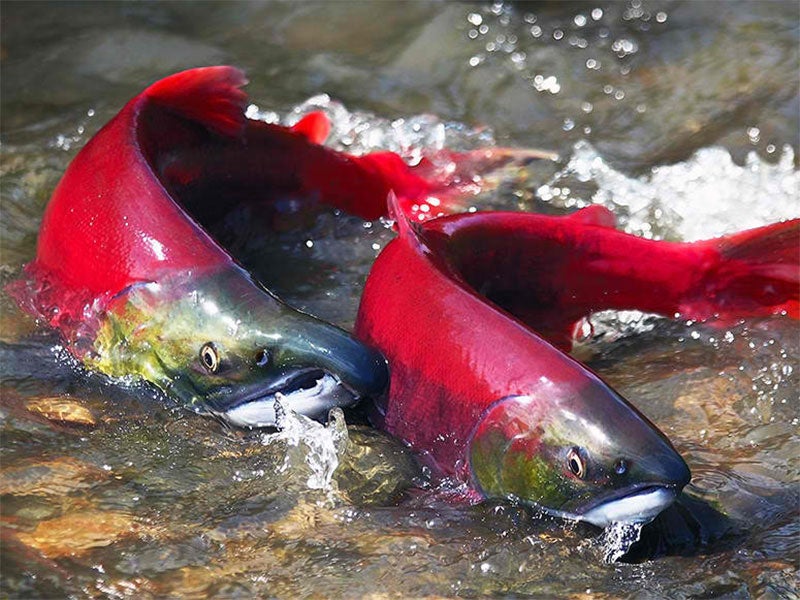Earthjustice goes to court for our planet.
We’re here because the earth needs a good lawyer.
We’re Going to Court to Protect Salmon from a Highly Toxic Chemical
This page was published 2 years ago. Find the latest on Earthjustice’s work.
What happened: Earthjustice is representing fishing groups in a lawsuit against U.S. tire manufacturers over the use of 6PPD in rubber tires. This chemical interacts with ground-level ozone to create a toxin called 6PPD-q that has devastating impacts on coho salmon and steelhead trout.
Why it matters: Exposure to 6PPD-q can kill coho salmon within hours, and the chemical is largely responsible for “urban runoff mortality syndrome,” which can kill up to 100% of salmon returning to freshwater streams to spawn in the Pacific Northwest before they can lay eggs. The Environmental Protection Agency recently committed to develop regulations for 6PPD in response to a petition brought by Pacific Northwest tribes.
Salmon and steelhead are keystone species that support entire ecosystems, and their loss has cascading effects on ocean biodiversity as well as the national economy. California’s entire salmon fishing fleet has been thrown out of work this year because salmon have been dying in the state’s rivers, many of which are polluted by 6PPD, before they can spawn and lay eggs.
What is 6PPD and 6PPD-quinone?
- It’s in our tires: 6PPD is present in most, if not all, tires. Tire manufacturers have used 6PPD since the 1950s to keep tires from degrading too quickly.
- The creation of 6PPD-q: By design, 6PPD transforms at the surface of the tire or when released into the environment into byproducts, including 6PPD-quinone (or “q”). 6PPD-q is then picked up during storm events and discharged into nearby waterways where it has devastating impacts on Endangered Species Act (ESA)-protected salmon and steelhead.
- 6PPD-q is the second most toxic chemical to aquatic species ever evaluated: Exposure to 6PPD-q can kill a coho salmon within hours, and the chemical is responsible for “urban runoff mortality syndrome,” which kills up to 100% of coho returning to spawn in urban streams. 6PPD-q is also toxic to other species of salmon such as Chinook.
The loss of salmon and steelhead trout is a threat to biodiversity and economy
- Impacts down the food chain: Coho salmon and steelhead trout are keystone species that support entire ecosystems. At least 135 other species depend on salmon and steelhead for food, including southern resident killer whales, eagles, bears, wolves, and seals.
- Economic importance of salmon: Robust salmon stocks are also important to the national economy, once supporting an estimated 16,000 jobs in the west coast’s commercial and recreational fishing industry.
- 6PPD is killing jobs: California’s entire salmon fleet has been thrown out of work this year because too few salmon have been surviving as juveniles in the state’s rivers, many of which are now polluted by 6PPD-q from urban runoff.
Tire companies are violating the Endangered Species Act
- Failing to take critical action: Tire manufacturers have known for years that they must invest in viable alternatives, yet they continue to kill critically imperiled salmon and other fish protected under the ESA.
- Recent Environmental Protection Agency decision: The Environmental Protection Agency recently granted a petition to address the use of 6PPD in tires to help protect salmon, noting that “concentrations of 6PPD-quinone in stormwater in the Pacific Northwest were found to be lethal to coho salmon after only a few hours of exposure.”
- Holding tire companies accountable: Earthjustice filed a lawsuit on behalf of the Institute for Fisheries Resources and Pacific Coast Federation of Fishermen’s Associations against 13 of the largest U.S. tire manufacturers, including Goodyear, Michelin, and Bridgestone. The complaint states that 6PPD in tires is imperiling the recovery of 24 populations of coho, Chinook salmon, and steelhead trout that are listed as endangered or threatened under the federal ESA.
